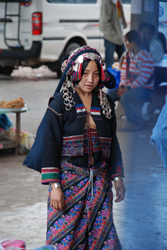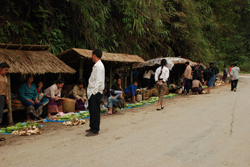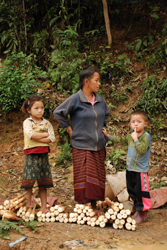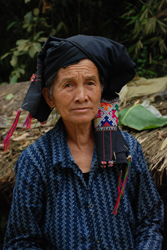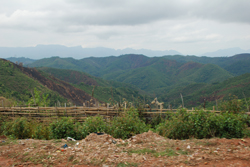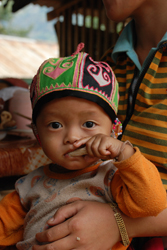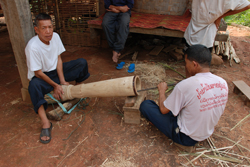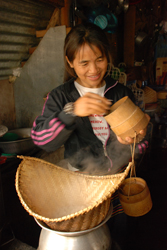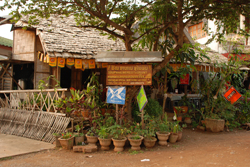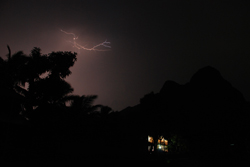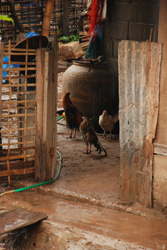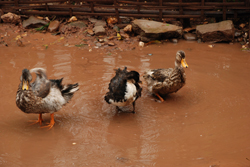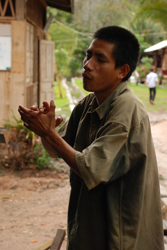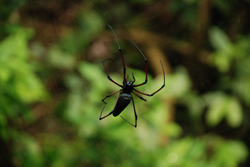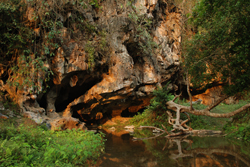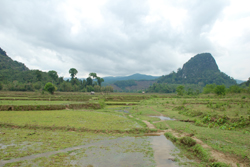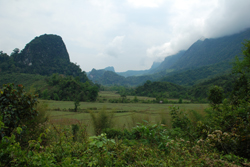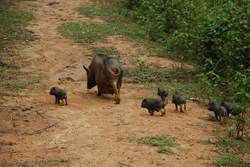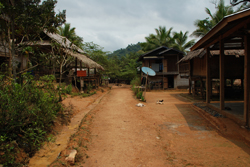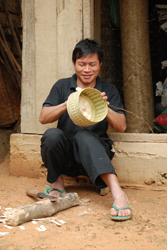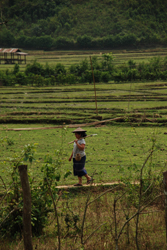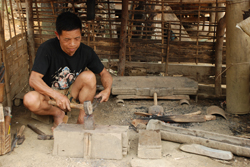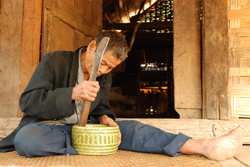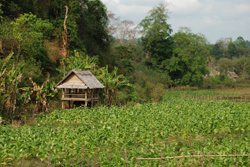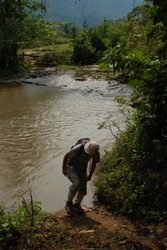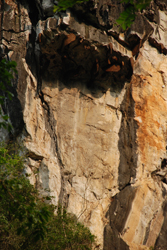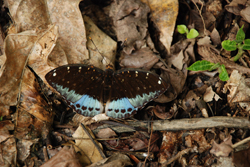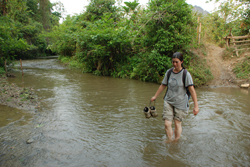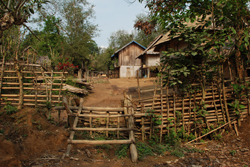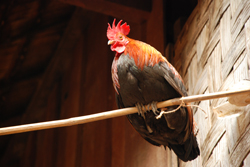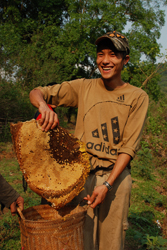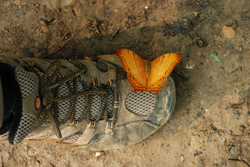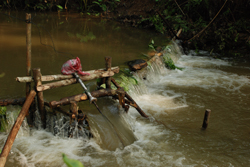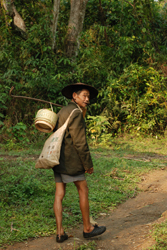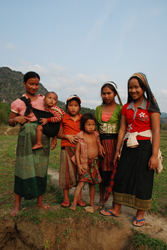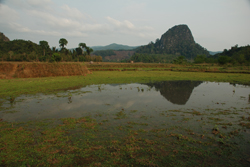The Road to Luang Namtha
8 April, 2009, 04:32 am in "Laos"
We got to the bus station 1.5 hours early and were surprised to see the bus was quickly filling up. We thought we'd just buy the tixkets and find an internet place but instead, R bought tickets while I claimed a couple of the few remaining seats. Then we just hung out. The bus was filled so there were 5 people in the 4 back seats and several more sitting on stools stuck in the aisle. Later I learned from the English guys we met in Nong Khiaw (who we later met again in Luang Namtha), that this was nothing. When they took the 3:00PM bus from Udomxai, there were 40+ people crammed onto a bus with seats for 19. Their bus broke down in Natuey, about 40 km from Namtha.
At the bus station, we noticed a woman in a beautiful headdress and traditional jacket (though she wore leggings and a print skirt underneath.) The headdress was decorated with coins, so I think that means she was from the Akha tribe. I thought she looked like a lost princess. The bus left a little after 11.
The road wound through the hills. The highlight of the trip was a snack stop by the roadside produce market. Women had piles of cucumbers, bamboo shoots, mushrooms, which they poured into packets made from banana leaves, tamarinds, and other foods-- perhaps plants found in the forest. Some of the women wore beautiful black fabric scarves with colorful embroidery. Many wore hand woven sinh (skirts)-- an increasingly rare sight with the availability of cheap printed materials.
At the bus station, we noticed a woman in a beautiful headdress and traditional jacket (though she wore leggings and a print skirt underneath.) The headdress was decorated with coins, so I think that means she was from the Akha tribe. I thought she looked like a lost princess. The bus left a little after 11.
The road wound through the hills. The highlight of the trip was a snack stop by the roadside produce market. Women had piles of cucumbers, bamboo shoots, mushrooms, which they poured into packets made from banana leaves, tamarinds, and other foods-- perhaps plants found in the forest. Some of the women wore beautiful black fabric scarves with colorful embroidery. Many wore hand woven sinh (skirts)-- an increasingly rare sight with the availability of cheap printed materials.
The passengers poured out of the bus, returning with their purchases, munching on cucumbers. As the bus was about to pull away, Rowshan made a last minute purchase, beckoning a woman to pass cucumbers to us through the bus window.
The young man sitting next to Rowshan took Rowshan's questions about cucumber prices as an invitation to speak. He had said a few words at the bus station but then the bus left and he was quiet. I think he really wanted to speak but was shy. It turns out he had been studying English at home at night using a dictionary and practicing reading and writing. (I think he'd had some English classes for a year or so at school as well). Soon he and Rowshan were chatting. He spoke English fairly well for someone just studying on their own, using a lantern at night since they had no electricity. His name was Puma, was 22 and lived in Ban Na Tuey, a village about 40 km from Namtha. He was a farmer and had a wife and a 1 year old daughter. He looked a lot younger. In his village there were also Thai Lao, and Lanten (I think). Rowshan asked if he could recognize a Khmu person by face-- clarifying by asking if the guys in front of us where Khmu. Puma laughed and said, "Yes, I can... black and beautifull". As often happens in these kind of bus conversations-- it started to late and ended too early since soon we arrived in Ban Na Tuey and our new friend had to leave.
Soon we came to Luang Namtha. A new bus stop about 10km out of town had been built so we had to take a tuk-tuk to the center, which was incredibly hard to recognize as the center of a town. Luang Namtha is either a tiny town or a large village. The main street had a small market and several hotels and a couple restaurants. The other main business in town was trekking agencies. I noticed they all had boards posted listing tours but didn't notice anyone signed up for any.
At the market we ran into John, the bird watcher and his friends. They confirmed that the weather had been rainy since they arrived (They left for Namtha the day we left for Muang Ngoi). They had been to many trekking agencies and found them expensive and with no other people signed up. They also reported Muang Sing was miserable and they stayed at the worst guesthouse of their trip and fled the next morning. (with the few other tourists who had the misjudgement to go there.)
Having nothing else to do, we went back to the hotel. The people in the neighboring rooms were noisy and didn't understand (or didn't want to understand) Rowshan's request for them to be quiet. Outside, some people were gathering playing a guitar and singing (Why are they always in front of where we are staying?) We heard some drunk farang join them. It was midnight. We were tired and it didn't look like sleep would be easy.
Trekking didn't look like it would be a pleasant experience with the weather and the cost. So, we decided to go on to Thailand the next day.
The young man sitting next to Rowshan took Rowshan's questions about cucumber prices as an invitation to speak. He had said a few words at the bus station but then the bus left and he was quiet. I think he really wanted to speak but was shy. It turns out he had been studying English at home at night using a dictionary and practicing reading and writing. (I think he'd had some English classes for a year or so at school as well). Soon he and Rowshan were chatting. He spoke English fairly well for someone just studying on their own, using a lantern at night since they had no electricity. His name was Puma, was 22 and lived in Ban Na Tuey, a village about 40 km from Namtha. He was a farmer and had a wife and a 1 year old daughter. He looked a lot younger. In his village there were also Thai Lao, and Lanten (I think). Rowshan asked if he could recognize a Khmu person by face-- clarifying by asking if the guys in front of us where Khmu. Puma laughed and said, "Yes, I can... black and beautifull". As often happens in these kind of bus conversations-- it started to late and ended too early since soon we arrived in Ban Na Tuey and our new friend had to leave.
Soon we came to Luang Namtha. A new bus stop about 10km out of town had been built so we had to take a tuk-tuk to the center, which was incredibly hard to recognize as the center of a town. Luang Namtha is either a tiny town or a large village. The main street had a small market and several hotels and a couple restaurants. The other main business in town was trekking agencies. I noticed they all had boards posted listing tours but didn't notice anyone signed up for any.
At the market we ran into John, the bird watcher and his friends. They confirmed that the weather had been rainy since they arrived (They left for Namtha the day we left for Muang Ngoi). They had been to many trekking agencies and found them expensive and with no other people signed up. They also reported Muang Sing was miserable and they stayed at the worst guesthouse of their trip and fled the next morning. (with the few other tourists who had the misjudgement to go there.)
Having nothing else to do, we went back to the hotel. The people in the neighboring rooms were noisy and didn't understand (or didn't want to understand) Rowshan's request for them to be quiet. Outside, some people were gathering playing a guitar and singing (Why are they always in front of where we are staying?) We heard some drunk farang join them. It was midnight. We were tired and it didn't look like sleep would be easy.
Trekking didn't look like it would be a pleasant experience with the weather and the cost. So, we decided to go on to Thailand the next day.
Eating Well in Udomxai
7 April, 2009, 04:32 am in "Laos"
We arrived in Udomxai after a trip which was windy but chicken-casualty free. I think this was because, judging from the rear view mirror decorations, was Buddhist. He slowed down and honked, letting the chickens scramble across the street. It was a trip through green mountains past wood and bamboo villages. Sometimes the driver would stop trying to find some more passengers (there were just 6 foreigners inside). At one village men were carving a drum from wood. There was a loom under one house where a woman was working.
Udomxai is a dusty, rather unappealing town at first glance. But, when we climbed up a to a stupa, off the main street, the city dissolved into fields and tree covered mountains. But after the bus ride, we just managed to find dinner (perhaps the best restaurant in Laos), Souphailins Restaurant. They had great food and lovely presentation. They even managed to make a nice environment-- wood patio with potted plants, 1/2 a block away from the dusty street.
DIY Trek to Ban Na and Huay Xien
6 April, 2009, 06:32 am in "Laos"
There was a crazy storm last night. As we walked home from the restaurant, sprinkles of rain started and the sky was lit with flashes of lightning from at least 2 sides-- a convergence of storms perhaps. I decided to stay inside the bungalow while Rowshan went out to take photos. Then the rain began to rush down in a torrent. The wind picked up, shaking the trees so the scene resembled the news video I'd seen of tropical hurricanes. The storm went on gushing down on the roof. I was glad we'd opted for a newer bungalow with fiberglass roofing and wood interior walls. I wondered how the hole-filled bamboo thatch ones were surviving.
The storm went on through the night. Then it stopped. At 4AM the roosters woke up and started crowing only to be silenced by another violent storm. It didn't look like promising weather for a trek.
It continued to rain intermittently through the morning. We tried out the banana pancakes with homemade peanut butter and honey at the restaurant we've been eating at. They seemed a bit small and a little salty but with honey added they were pretty good.
The rain started up again. We watched delighted ducks waddling, shaking their tail feathers, shoveling with their bills in mud puddles and copulating. They seemed to be rejoicing that the chickens who usually fill the streets were hiding under the houses trying to keep out of the rain.
Lao singer
It looked like things were clearing up. Then it started to rain again. Then it stopped and we decided perhaps that was it for the day. I remembered John, the bird watcher, had said, "Here it rains every day. You just don't know when.
We set off for the trail. The trail was easier to walk on than the main road. For some reason it seemed to dry quicker and the mud was less difficult. The rain had stopped but the weather hadn't become hot and heavy with humidity and heat yet. Near one patch of stream/mud we saw a huge black spider (about the size of my hand) with a huge web. Rowshan edged around a down tree nearby to try to get a better photo of the spider. Just then I noticed a leach crawling up my shoe. I sounded a leach alert and Rowshan quickly left the muddy area in time to scrape a couple leaches off his shoes before they got to the more succulent ankle area above. After the leach ambush, we tucked our pants into our socks and conducted periodic checks.
The storm went on through the night. Then it stopped. At 4AM the roosters woke up and started crowing only to be silenced by another violent storm. It didn't look like promising weather for a trek.
It continued to rain intermittently through the morning. We tried out the banana pancakes with homemade peanut butter and honey at the restaurant we've been eating at. They seemed a bit small and a little salty but with honey added they were pretty good.
The rain started up again. We watched delighted ducks waddling, shaking their tail feathers, shoveling with their bills in mud puddles and copulating. They seemed to be rejoicing that the chickens who usually fill the streets were hiding under the houses trying to keep out of the rain.
We weren't as pleased with the rain. The main road became full with mud which alternated between slippery and sticky. But we were happy about the rain forcing people to stay indoors.
We walked back and noticed some people eating pho in a covered area. A young man was singing very well, accompanying himself by clapping. Later he was at the restaurant across the street from our hotel. A woman, perhaps our guesthouse owner, told me, "He is very poor and has no mother, no father. He sings for money." I passed this info on to Rowshan who gave him some money.
We walked back and noticed some people eating pho in a covered area. A young man was singing very well, accompanying himself by clapping. Later he was at the restaurant across the street from our hotel. A woman, perhaps our guesthouse owner, told me, "He is very poor and has no mother, no father. He sings for money." I passed this info on to Rowshan who gave him some money.
Lao singer
It looked like things were clearing up. Then it started to rain again. Then it stopped and we decided perhaps that was it for the day. I remembered John, the bird watcher, had said, "Here it rains every day. You just don't know when.
We set off for the trail. The trail was easier to walk on than the main road. For some reason it seemed to dry quicker and the mud was less difficult. The rain had stopped but the weather hadn't become hot and heavy with humidity and heat yet. Near one patch of stream/mud we saw a huge black spider (about the size of my hand) with a huge web. Rowshan edged around a down tree nearby to try to get a better photo of the spider. Just then I noticed a leach crawling up my shoe. I sounded a leach alert and Rowshan quickly left the muddy area in time to scrape a couple leaches off his shoes before they got to the more succulent ankle area above. After the leach ambush, we tucked our pants into our socks and conducted periodic checks.
Next we came to Tham Pa Kaew which contains a couple caves next to the river. Here we had to pay admission and sign a book in order to continue on the trail.
We forded a shallow river and came to a stretch of fallow rice paddies with ruined bamboo woven huts/ shelters. We'd already passed many other rice paddies with rice so I wondered why these were empty. Here the trail got a little confusing since there were many trails through the fields. Then I noticed a sign "Huay Xien Guesthouse with an arrow that would have been pointing left if the sign hadn't been positioned upside down. I assumed the sign in its upside down condition pointed in the right direction and had just been placed upside down due to lack of English knowledge. If it had been right side up it would have pointed back to Muang Ngoi.
As we followed the trail pointed out by the sign we saw a fairly obvious red clay path directly across from us. We decided to take that. Soon we came to a stilt house woven bamboo walled village. We were greeted with the angry grunts of a sow trying to protect her 6+ piglets who ran willy nilly trying to simultaneously get away from us and follow their mom.
Ban Na seemed like one of the busiest Lao villages we've seen. Most of the houses seemed to have someone from older men to young boys and women, weaving baskets from strips of bamboo. They used both white inner and green outer parts making pretty patterned baskets, delicately tucking the long strips under and over each other.
We also saw a blacksmith hammering a metal spike into shape which he grabbed with metal thongs. There was also a weaving loom which we passed. However, we were dissapointed that only one person even made an effort to sell us a basket (unfortunately a little too big-- we want a small sticky rice basket).
We both really liked the village. People were OK with Rowshan taking photos. They were industrious and the buildings seemed in relatively good condition. We came to a guesthouse/ restaurant just in time for lunch. The OB Guesthouse restaurant commanded a wonderful view of limestone mountain rising up like islands from a sea of rice paddies. Though the day had become hotter, a cool breeze made the spot even more alluring. There were several very basic bungalows for guests. The restaurant was also the owner's weaving studio. She had a loom set up with multicolored strings making up the warp.
The woman told us that Huay Xien was back down the road and off to the right from the fields about 1 hour away. Another village Huay Bo was up the road a little and to the left about 45 minutes away. She recommended Huay Xien. Going through town we came across a few more tourists. We were glad we'd gotten a head start (only 1 guy had signed in before us).
Back at the fallow fields we went right, past a shelter, and found the path ended. We went back into the fields. I noticed a limestone cliff and said we should head that way because a brochure I had said the hike to Huay Xien passes, "high limestone cliffs that typify the landscape in this part of Luang Prabang Province". We got on a path and soon came to a river which we had to ford. My leach-view socks (white and thick), are a bit tight so it took me a while to get them off (as well as my shoes). I hadn't finished putting my shoes back on when Rowshan called from ahead, "Don't bother, there is another river." We forded this one and then were able to keep our shoes on for a bit.
The woman told us that Huay Xien was back down the road and off to the right from the fields about 1 hour away. Another village Huay Bo was up the road a little and to the left about 45 minutes away. She recommended Huay Xien. Going through town we came across a few more tourists. We were glad we'd gotten a head start (only 1 guy had signed in before us).
Back at the fallow fields we went right, past a shelter, and found the path ended. We went back into the fields. I noticed a limestone cliff and said we should head that way because a brochure I had said the hike to Huay Xien passes, "high limestone cliffs that typify the landscape in this part of Luang Prabang Province". We got on a path and soon came to a river which we had to ford. My leach-view socks (white and thick), are a bit tight so it took me a while to get them off (as well as my shoes). I hadn't finished putting my shoes back on when Rowshan called from ahead, "Don't bother, there is another river." We forded this one and then were able to keep our shoes on for a bit.
As we walked under the huge limestone cliffs, we could see huge wild beehives hanging from the ledges. "They need to get cliff honey harvesters like they have in Nepal," I said. One ledge had a bunch of hives, hundreds of feet off the ground.
We walked quickly. The sun had come out but it was late enough in the day that it wasn't too hot and there were trees and cool stream gullies. From a small hill and were able to see the houses of Huay Xien in the distance, surrounded by forest and fields. We walked down the road and came to another river. This one, thankfully, had a down tree across it so I was happily able to keep shoes and socks on.
The owner of the guesthouse/restaurant, Kampong, greeted us. We told him we'd take a walk around town then come back. This was quick. I thought it was a nice enough village-- tidy with many houses in good condition. People said, "sabadi." Others just watched us from wooden windows. A couple had roosters leashed to perches outside the second story.
We had drinks at Kamopong's and I told him he needed to put signs in Muang Ngoi (with prices) so tourists would know about his place and that they could come and stay on their own without booking a tour. He was amazed we paid 60,000 in town. I responded, "But in town, an overnight trip here costs 200,000 kip through a tour company. People don't know a room is only 10,000 kip and they can come on their own."
We didn't stick around long because we wanted to be back before dark. On the way back we saw a group of men and boys carrying buckets full of pieces of a wild bee hive. A few bees still clung to it. Rowshan asked if they climbed to get it and they responded in the affirmative. But we think they climbed a tree not the cliff. It felt like a joyous return from a hunt. They let us sample a corner of beehive/honey and it tasted very fruity.
We didn't stick around long because we wanted to be back before dark. On the way back we saw a group of men and boys carrying buckets full of pieces of a wild bee hive. A few bees still clung to it. Rowshan asked if they climbed to get it and they responded in the affirmative. But we think they climbed a tree not the cliff. It felt like a joyous return from a hunt. They let us sample a corner of beehive/honey and it tasted very fruity.
We came to the river, Rowshan found some butterflies to photograph. One pretty gold one landed on his shoe. Across the log, I noticed a small metal spinning rod connected to something that looked like a small motor. The rod was in the water and the whole thing was supported by a wooden frame and dam. A wire ran from it. It was a tiny hydroelectric station. Kampong had mentioned that they have electricity all night when in Muang Ngoi, they just have it for a few hours. This little hydroelectrric station had apparently been installed in a couple minutes before we got there, by some teens (perhaps it was being serviced).
As we walked back, the dusk turned the surroundings clear and golden. Birds sang and crickets chirped. The heat of the afternoon was cooled in the shade of stream gullies. The green of the mountain side was broken by pale trunks of leafless trees which stretched over the foliage like fingers of ghosts. Never underestimate what can turn out to be a really beautiful day.
Powered by My Blog 1.69. Copyright 2003-2006 FuzzyMonkey.net.
Created by the scripting wizards at FuzzyMonkey.net..
(Code modified by Rowshan Dowlatabadi)
Created by the scripting wizards at FuzzyMonkey.net..
(Code modified by Rowshan Dowlatabadi)


